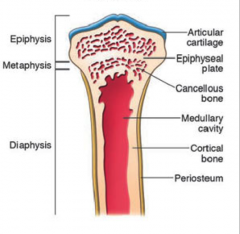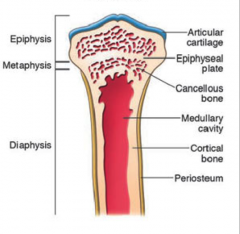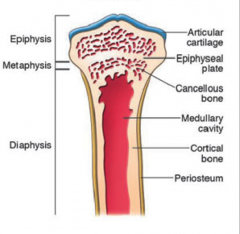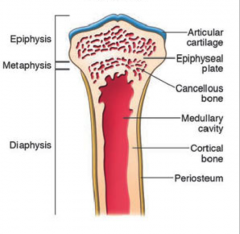![]()
![]()
![]()
Use LEFT and RIGHT arrow keys to navigate between flashcards;
Use UP and DOWN arrow keys to flip the card;
H to show hint;
A reads text to speech;
51 Cards in this Set
- Front
- Back
|
what are the two basic types of bone formation? |
1) intramembranous ossification
2) endochondral ossification
|
|
|
osteogenesis of membranous bone |
intramembranous ossification |
|
|
osteogenesis of endochondral bone |
endochondral ossification |
|
|
how do endochondral ossification and intramembranous ossification differ? |
endochondral ossification: bone formation requires a cartilage template;
intramembranous ossification: no cartilage template; bone forms directly from osteoblasts that differentiate from osteoprogenitors (mesenchymal stem cells) within a cellular mesenchyme (the source of the mesenchymal stem cells); plates of bone grow twoard eachother connected by CT sutures; growth cessation when bony plates meet |
|
|
where does endochondral ossification predominate (mostly)? |
cuboidal and sesamoid bones growth plates of the long bones also: condyles and rami of mandible
*many bones are formed by both endochondral & intramembranous ossification |
|
|
where does intramembranous ossification predominate (mostly)? |
calvaria also: diaphyseal cortices in long bones flat regions of pelvis, scapulae, vertebrae, etc
*many bones are formed by both endochondral & intramembranous ossification |
|
|
articular cartilage is made of what type of cartilage? |
hyaline cartilage
withstands compressive forces (weight bearing) and shear forces (motion)
no nerves or vessels
relies on synovial fluid (diffusion) for nutrition and waste removal- requires moving!
|
|
|
epiphysis |

articular cartilage & subchondral bone @ the distal/articular ends of long bones
(contains red bone marrow which produces erythrocytes)
|
|
|
physis/physes |

growth plates |
|
|
metaphysis |

between the epiphysis and diaphysis on long bones narrowing zone just below the metaphyseal growth plate (same as epiphyseal plate in this picture)
|
|
|
diaphysis |

shaft of the long bone; cortical bone w/ medullary cavity
|
|
|
hyaline cartilage |
-lines the articular surfaces of synovial joints
-undergoes endochondral ossification during bone development |
|
|
what is cartilage and what are the 3 types of cartilage? |
specialized connective tissue 1) hyaline cartilage 2) fibrocartilage 3) elastic cartilage |
|
|
mature cells of cartilage |
chondrocytes |
|
|
what are the components of the extracellular matrix (ECM) of cartilage? |
1) collagen fibers (mostly type II cartilage) 2) hydrophillic ground substance 3) water |
|
|
cartilage is made up of... |
cells: chondroblasts & chondrocytes
ECM |
|
|
what are osteoclasts (OCL)? |
-bone resorption cells; -of macrophage/monocyte lineage, -breakdown & resorb bone (in large amounts) -are multinucleate -do not eat unmineralized bone (soggy nachos) |
|
|
what are bone stem cells called? |
osteoprogenitor cells -the only bone cell capable of mitosis! pluripotent |
|
|
periosteum |
covers the external surface of bone except where tendons and muscles attach; -tough outer fibrous layer -cellular inner cambium layer (where bone progenitor cells are located) |
|
|
endosteum |
lines the inner surfaces of compact and trabecular bone |
|
|
what can both the periosteum and endosteum form during healing? |
a healing callus (more exuberant in periosteum than endosteum) |
|
|
what do osteoblasts (OB) do? |
they secrete large amounts of bone matrix to form bone; control both bone formation and resorption |
|
|
bone matrix is |
acellular components of bone 1) osteoid (organic component) 2) hydroxyapatite (inorganic component) |
|
|
what is osteoid? |
organic component of the acellular bone matrix secreted by osteoblasts consists of: -90% Type I collagen fibers -10% amorphous ground (proteins, etc., which bind Ca) |
|
|
what is hydroxyapatite? |
inorganic component of the acellular bone matrix; OB secretion is biphasic (osteoid is made first)
made up of various minerals: Ca, PO4, Mg, citrate
|
|
|
what do osteocytes (OC) do? |
1) maintain bone matrix 2) communicate 3) resorb small amounts of bone for calcium homeostasis |
|
|
what is the AEC complex? |
AEC = articular and epiphyseal complex; where the hyaline articular cartilage and the subchondral bone of the epiphysis meet; mineralizes and anchors articular cartilage to subchondral bone; occurs when growth plates close (no more ECO) Although the major component of growth in long bones occurs at the metaphyseal growth plates (e.g. "the physis"), endochondral ossification of the occurs within the epiphyses too (ice cream scoop analogy). |
|
|
what factors are involved in osteoclast (OCL) regulation? |
1) RANKL- OC differentiation factor; made by OB; promotes resorption w/ inflam. cytokines (TNF-alpha, IL-1, IL-6) 2) osteroprotegerin (OPG) made by OB; decoy receptor for RANKL to inhibit OCL 3) calcitonin made by C-cells of thyroid; directly inhibits OCL resorption & causes OCL apoptosis 4) parathyroid hormone (PTH) from parathyroid glands; indirectly stimulates bone resorption; |
|
|
bone formation/resorption regulation |

review pathways I drew |
|
|
parathyroid hormone (PTH) |
made in parathyroid glands promotes bone resorption (indirectly) by OCL |
|
|
calcitonin |
made by c-cells of thyroid inhibits OCL bone resorption |
|
|
1,25-dihydroxyvitamin D |
promotes bone growth & mineralization stimulates OCL resorption |
|
|
what does Ricketts affect, in young animals? |
Metabolic bone diseases that occur in young growing animals (e.g. Rickets) will affect active centers of ossification (ECO) in addition to sites of physiologic remodeling (bone turnover). |
|
|
where does endochondral ossification occur? |
metaphyseal growth plate of long bones, cuboidal and sesamoid bones
REVIEW STEPS OF ENDOCHONDRAL OSS.!!! exam
ECO ends when growth plates close and the AEC forms (mineralized tide-line) |
|
|
zones of ECO: |
1) resting zone 2) zone of proliferation 3) zone of hypertrophy - leads to mineralization and capillary ingrowth 4) zone of ossification (mineralization) - osteoid production and additional mineralization |
|
|
where do chondrocytes develop during ECO? |
perichondrium |
|
|
what happens when articular cartilage is lost? |
results in SCLEROSIS (thickening) of the subchondral bone, as articular cartilage acts as shock absorber--> less shock absorption, decreased joint health and more joint pain
e.g. degenerative joint disease changes include sclerosis of subchondral bone, loss of proteoglycan staining, formation of chondrocyte clones (chondrones) |
|
|
what is compact (osteonal or cortical) bone? |
* has well-defined concentric lamellae (layers) which surround a central (Haversian) canal.
* is very dense and strong per unit volume. * is predominantly found in the diaphyseal cortex of long bones and bears the brunt of the compressive/tensile forces. |
|
|
what is trabecular (cancellous or spongy) bone? |
* consists of interconnecting plates of bone separated by marrow spaces (fibroadipose tissue with interspersed thin walled vascular sinuses)
* are concentrated within the epiphyses and metaphyses and serve to absorb and re-distribute forces to the diaphyseal cortices. * has a very high surface:volume area and serves as a mineral reserve for calcium and phosphorous. Due to their "accessibility" to osteoclasts and blood supply, they are preferentially resorbed when calcium and phosphate minerals are needed (e.g. during lactation). |
|
|
lamellar bone |
mature layers of bone that form osteons or trabeculae; very well organized (reflects parallel alignment of mineralized Type I collagen fibers)
Lamellar bone formation occurs in times of rest during "quiet" physiologic remodeling processes.
stronger per unit area due to organized fibers
can form in compact (osteonal) or trabecular (spongy, cancellous) bone |
|
|
woven bone |
-immature bone: primary, immature or reactive bone; -more cellular, haphazard organization of Type I collagen fibers and bone matrix -bone formed in times of "emergency," and serves as a "bandaid." It is formed in rapid responses to a strong stimulus (e.g. fracture repair, infection, aggressive neoplasms, rapid growth). Eventually (with time), will be remodeled into lamellar bone (e.g. during "quiet, restful times" once the lesion or growth phase is stabilized). -weaker per unit area due to disorganized fibers -can form in compact (osteonal) or trabecular (spongy, cancellous) bone |
|
|
What are the features of compact vs trabecular bone? |
compact: well-defined concentric lamellae make up an osteon surrounding a central Haversian canal; very strong per unit volume; mostly found in diaphyseal cortex of lone bones; bears the brunt of the compressive/tensile forces
trabecular: interconnected plates of bone matrix surrounded by marrow spaces- honeycomb-like pattern; large interconnecting surface area; found more at the epiphyses & metaphyses than diaphysis, surrounded by hematopoetic marrow. |
|
|
What is the difference between lamellar and woven bone? |
main diff is rate of formation- TIME:
lamellar= mature, organized bone, parallel lemellae w/ regular interspersed cement lines; much stronger and denser than woven. formed more slowly.
woven bone= primary, immature, reactive; more cellular than lamellar; weaker than lamellar; forms more rapidly than lamellar; many irregular basophilic reversal cement lines; forms during rapid growth, or in response to trauma or disease
BOTH types can be in compact OR trabecular bone |
|
|
why is bone a plastic organ? |
1) adapts to change 2) rigid yet flexible 3) accomplises the above through MODELING & REMODELING - which involves the coupling of absorption and resorption |
|
|
characteristics of bone MODELING |
= immature woven --> lamellar bone 1) think young bone or repair bone 2) ADAPTIVE process 3) results in architectural change- size, structure, orientation, contour 4) during growth or during pathologic states |
|
|
characteristics of bone REMODELING |
1) PHYSIOLOGIC replacement of old bone tissue with new bone tissue (3 month process) - cyclical turnover of bone) 2) in adults, purpose is to: -maintain bone mass -repair microfractures -respond to metabolic changes or disease states
|
|
|
A-R/r-F cycle |
in bone remodeling: (occurs locally- w/ OCLs & OBs) 1) activation-stimulated by cytokines, GFs, OCLs 2) resorption-OCLs digest old bone matrix 3) reversal-end of resorption (basophilic cement line- delineates reversal zone) 4) formation- OBs synthesize new bone 5) Quiescence |
|
|
where does remodeling occur in osteonal bone? in trabecular bone? |
osteonal: occurs in Haversian (osteonal/central canals)
trabecular: endosteal surfaces of trabecular bone (more than in Haversian canals of compact bone) |
|
|
diarthroses |
synovial joints: allow movement of appendicular bones w/ minimal friction stifle, hock, fetlock, elbow
|
|
|
synovial joint structure |
1) articulation of two bones ending in articular (hyaline) cartilage and subchondral bone plate 2) supported by a fibrous joint capsule containing blood vessels and nerves, ligaments, menisci 3) capsule is lined by a synovial membrane which secretes synovial fluid (lubrication and nutrients for articular cartilage) |
|
|
components of articular cartilage |
(hyaline cartilage)
chondrocytes- secrete proteoglycan part of ECM
ECM- very important, very hydrophilic, acts as shock absorber; made of proteoglycans and Type II collagen fibers |

